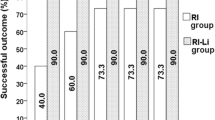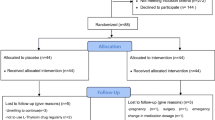Abstract
Objective
In spite of previous conflicting results, an adjuvant role of selenium in the treatment of Graves’ disease (GD) hyperthyroidism has been proposed. To address this issue, a randomized clinical trial was carried out aimed at investigating whether selenium is beneficial on the short-term control of GD hyperthyroidism treated with methimazole (MMI).
Methods
Thirty newly diagnosed hyperthyroid GD patients were randomly assigned to treatment with: (i) MMI or (ii) MMI plus selenium. Primary outcomes were: control of hyperthyroidism and clinical and biochemical manifestations of hyperthyroidism [heart rate, cholesterol, sex hormone-binding globulin (SHBG), hyperthyroidism symptoms] at 90 days.
Results
Baseline features of the two groups did not differ. Serum selenium at baseline was similar in the two groups and within the recommended range to define selenium sufficiency. Selenium increased with treatment in the MMI-selenium group and became significantly higher than in the MMI group. Serum malondialdehyde, a marker of oxidative stress, was similar in the two groups and decreased significantly with treatment, with no difference between groups. Administration of MMI was followed by a reduction of FT3 and FT4, with no difference between groups. Heart rate, SHBG and symptoms of hyperthyroidism decreased, whereas total cholesterol increased in both groups with no difference between groups.
Conclusions
Our study, carried out in a selenium-sufficient cohort of GD patients, failed to show an adjuvant role of selenium in the short-term control of hyperthyroidism. However, selenium might be beneficial in patients from selenium-deficient areas, as well as in the long-term outcome of antithyroid treatment.



Similar content being viewed by others
References
Rayman MP (2000) The importance of selenium to human health. Lancet 356:233–241.2
Kieliszek M, Błażejak S (2016) Current Knowledge on the importance of selenium in food for living organisms: a review. Molecules 10:E609
Steinbrenner H, Speckmann B, Klotz LO (2016) Selenoproteins: antioxidant selenoenzymes and beyond. Arch Biochem Biophys 595:113–119
Wrobel JK, Power R, Toborek M (2015) Biological activity of selenium: revisited. IUBMB Life 68:97–105
Diamond AM (2015) The subcellular location of selenoproteins and the impact on their function. Nutrients 7:3938–3948
Burk RF, Hill KE (2015) Regulation of selenium metabolism and transport. Annu Rev Nutr 35:109–134
Kipp AP, Strohm D, Brigelius-Flohé R, Schomburg L, Bechthold A, Leschik-Bonnet E, Heseker H, German Nutrition Society (DGE) (2015) Revised reference values for selenium intake. J Trace Elem Med Biol 32:195–199
Köhrle J (2015) Selenium and the thyroid. Curr Opin Endocrinol Diabetes Obes 22:392–401
Duntas LH, Benvenga S (2015) Selenium: an element for life. Endocrine 48:756–775
Esposito D, Rotondi M, Accardo G, Vallone G, Conzo G, Docimo G, Selvaggi F, Cappelli C, Chiovato L, Giugliano D, Pasquali D (2016) Influence of short-term selenium supplementation on the natural course of Hashimoto’s thyroiditis: clinical results of a blinded placebo-controlled randomized prospective trial. J Endocrinol Invest. doi:10.1007/s40618-016-0535-4
de Farias CR, Cardoso BR, de Oliveira GM, de Mello Guazzelli IC, Catarino RM, Chammas MC, Cozzolino SM, Knobel M (2015) A randomized-controlled, double-blind study of the impact of selenium supplementation on thyroid autoimmunity and inflammation with focus on the GPx1 genotypes. J Endocrinol Invest 38:1065–1074
Marcocci C, Kahaly GJ, Krassas GE, Bartalena L, Prummel M, Stahl M, Altea MA, Nardi M, Pitz S, Boboridis K, Sivelli P, von Arx G, Mourits MP, Baldeschi L, Bencivelli W, Wiersinga W (2011) Selenium and the course of mild Graves’ orbitopathy. N Engl J Med 364:1920–1931
Leporati P, Groppelli G, Zerbini F, Rotondi M, Chiovato L (2015) Etiopathogenesis of Basedow’s disease. Trends and current aspects. Nuklearmedizin 54:204–210
Marinò M, Latrofa F, Menconi F, Chiovato L, Vitti P (2015) Role of genetic and non-genetic factors in the etiology of Graves’ disease. J Endocrinol Invest 38:283–294
Komosinska-Vasseva K, Olczyk K, Kucharz EJ, Marcisz C, Winsz-Szczotka K, Kotulska A (2000) Free radical activity and antioxidant defense mechanisms in patients with hyperthyroidism due to Graves’ disease during therapy. Clin Chim Acta 300:7–117
Guerra LN, Rios de Molina M, Miler EA, Moiguer S, Karner M, Burdman JA (2005) Antioxidants and methimazole in the treatment of Graves’ disease: effect on urinary malondialdehyde levels. Clin Chim Acta 352:115–120
Venditti P, Balestrini M, Di Meo S, De Leo T (1997) Effect of thyroid state on lipid peroxidation, antioxidant defenses, and susceptibility to oxidative stress in rat tissues. J Endocrinol 155:151–157
Vrca VB, Mayer L, Skreb F, Rahelić D, Marušić S (2012) Antioxidant supplementation and serum lipids in patients with Graves’ disease: effect on LDL-cholesterol. Acta Pharm 62:115–122
Calissendorff J, Mikulski E, Larsen EH, Möller M (2015) A prospective investigation of Graves’ disease and selenium: thyroid hormones, auto-antibodies and self-rated symptoms. Eur Thyroid J 2:93–98
Profilo MA, Sisti E, Marcocci C, Vitti P, Pinchera A, Nardi M, Rocchi R, Latrofa F, Menconi F, Altea MA, Leo M, Rago T, Marinò M (2013) Thyroid volume and severity of Graves’ orbitopathy. Thyroid 23:97–102
Acknowledgments
Unconditionally supported by IBSA Farmaceutici Italia, Lodi, Italy and partly supported by a Grant from the Italian Ministry of Education, University and Research (MIUR, PRIN #2012Z3F7HE to LB).
Author information
Authors and Affiliations
Corresponding author
Ethics declarations
Conflict of interest
The authors declare that they have no conflict of interest.
Ethical approval
Local Review Board, Comitato Etico Area Vasta Nord Ovest, Board Affiliation: Comitato Etico Regionale per la Sperimentazione Clinica, Approval Number: 3804.
Informed consent
Informed consent was obtained from all individual participants included in the study.
Rights and permissions
About this article
Cite this article
Leo, M., Bartalena, L., Rotondo Dottore, G. et al. Effects of selenium on short-term control of hyperthyroidism due to Graves’ disease treated with methimazole: results of a randomized clinical trial. J Endocrinol Invest 40, 281–287 (2017). https://doi.org/10.1007/s40618-016-0559-9
Received:
Accepted:
Published:
Issue Date:
DOI: https://doi.org/10.1007/s40618-016-0559-9




